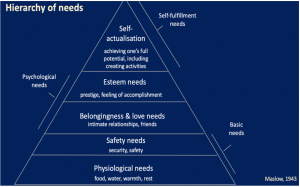Have you ever seen one of those old maps with the dragons on the edges? During Medieval times, unknown lands at the edges of a map were marked by dragons or other ominous looking creatures. It comes to no surprise that most of us are afraid of the unknown and it often takes great bravery to overcome our fears. As humans, we have evolved over the years and survived many dangers because of the way our bodies and minds are designed to protect us from danger. And now, after all this time, not much has changed. The same physiological chemicals are at play and our minds do not stop looking out for danger. The important difference though, is that our surroundings have changed and instead of facing a saber-tooth tiger, we are facing more subtle, but nonetheless ruthless dangers that threaten our happiness (and consequently our health) on a daily basis.

This article sets out to explore the role of the leadership team and mental health in the workplace. It sets out the truth about ‘health’ in the context of our lives today- in our Western World reality, and why it has become so critically important for us to be brave and overcome challenges that stop us from understanding mental health as an integral part of health in the workplace. It also includes a 5-step approach for organisations to make a difference.
The health continuum
Over the course of our lives, the status of our health will fluctuate up, down and around a continuum (illustrated below). Sometimes we will know what’s wrong and other times we will have no choice but to just ride out the symptoms. Sometimes we will be able to take medication to treat an illness, and other times, we will need to change our lifestyle and adapt to different choices. Health, whether it is physical, (e.g. a headache, a broken bone, diabetes or an even more serious illness such as cancer); or mental (e.g. tiredness, anxiety, a depressive episode or a more serious illness such as schizophrenia) is a part of life and we should accept this.

The more we know and understand, the more we are able to prevent, manage and treat ill health.
Most organisations nowadays have robust and sophisticated health and safety strategies, policies and support in place, including first aiders. The role of the first aider is normally to support people with injuries or illness at work until medical professionals can take over. However, not all organisations have included mental health into their strategy yet.
Not including mental health into a health and safety strategy could very well prove to cost organisations money and could make the difference between a successful business and an unsuccessful business. Here’s why…
We live and work in a ‘VUCA’ (volatile, uncertain, complex, ambiguous) world
There is quite a lot of research into the topic of ‘future leaders’ in the workplace and it is highlighted how our world has changed in terms of the increased pace of information influx via social media, globalisation and generational differences that brings new expectations. Researchers talk about a VUCA world of work- where there is a plethora of information to digest relentlessly; bringing a sense of feeling overwhelmed and not in control. As a consequence, more and more decisions and objectives are underpinned by emotion instead of principles. They highlight how millennials (a younger generation of people entering the workforce) have different expectations from organisations compared to older generations. They claim that future leaders need to discover positive energy in each person in the workforce, to ensure everyone’s potential is achieved in this new world of work.
One could say that leadership in this context has a role to play in motivating and inspiring workers on an individual level to promote trust. A fast-paced working environment with increased ambiguity and complexity will need a trusting workforce for an organisation to stay successful. Prioritising your employees’ health (physical and mental) and safety (physically and psychologically) in a visible way can only help with this.
Organisations increasingly expect employees to be flexible and cope with the pace of change and that unless employees are resilient, there is a real risk of burnout which could lead to health issues which in turn would increase absenteeism and presenteeism, decrease talent retention, create knowledge and skill gaps and reduce productivity in the workplace.
Here are some concerning statistics…
- Mental ill health costs UK employers £34.9 billion each year
- Managers account for at least 70% of the variance in employee engagement scores
- UK workers have slightly worse health and well-being at work than average
- Two in five workers report having experienced some form of work-related health condition in the last 12 months (with 25% anxiety, 14% depression, 28% sleep problems)
- On average, only 45% of employees in the UK are engaged (compared to 54% in France, 56% in Australia and 60% in USA)
- One in five employees leave within 2 years of employment. These are typically workers with much higher levels of stress and who perceive their employers to be unsupportive of their work-life balance
- Work-related stress, anxiety or depression accounts for over half of all working days lost due to ill health in Great Britain (a total of 15.4 million working days in 2017/18)
Working days lost due to ill health has a significant impact on our socio-economic infrastructure and one could therefore reason that the role organisations could play to make a difference in our society is huge!
But what can leaders in organisations do? How is it possible to really make a difference? In the words of the famous London rap-artist, Professor Green: “The first thing people think about when you say, ‘mental health’ is just that first word– mental, you know, crazy– that stigma exists everywhere.”
Going back to the notion of being wary of the unknown (like those medieval maps with the dragons) the first step towards overcoming obstacles is to increase our knowledge, awareness and self-awareness. The more we know, the more we understand, and the more we understand the easier it becomes to do something about challenges that come our way.
Demystifying ‘mental health’
As humans, we have physical needs, i.e. food, water, warmth, physical safety. If our needs are not met, we could die. Equally, we also have mental needs, i.e. psychological safety, sense of belongingness, feeling of accomplishment, achieving our potential, etc. Again, if our needs are not met, we could get ill and in worse case scenarios, die. Did you know 6,000 people die by suicide every year in the UK and 80% are men?
Looking at Maslow’s hierarchy of human needs (illustrated on the diagram on the right), we are reminded how important our psychological needs are in addition to our basic human needs.

Our bodies, as humans, are designed to survive, and so what helped us to survive over the centuries are still very much there and still very relevant to our health and happiness today. As part of our biological make-up, we have two chemicals – endorphins and dopamine – that drives us to hunt, gather and achieve. They make us feel good when we find something we’re looking for; build something we need or accomplish our goals. These are our chemicals of progress.10 As most of us are at work for a large percentage of our lives, we look to ‘feed’ our chemicals of progress in the workplace. We strive to build futures, overcome challenges and achieve success. That’s why we need clear objectives and stretching goals to give us the means to find purpose and pleasure, which in turn promotes happiness and ultimately influences our health positively.
As humans, we are social animals and need each other to survive. Through the ages, we needed to work together to feel and be safe. And so- finding, building and achieving are only part of our story. It is the manner in which we make progress that is core to our ability to do well in a dangerous world. The selfless chemicals in our body – serotonin an oxytocin – make us feel valued when we are in the company of those we trust, give us a feeling of belonging and inspire us to want to work for the good of the group.10 This is why it is so important for leadership teams and people managers to ensure humanity is at the heart of business. When employees feel cared for, listened to and valued, they feel happier, and in turn more determined to be resilient; even during challenging times.
Then there is cortisol– the stress chemical. This chemical has saved human lives many a time over the ages. It shuts down less critical functions in our bodies to enable complete focus on surviving the moment. It drives the fight, freeze or flight instinct when we need it to survive. Stress can be healthy if it is not constant over a prolonged period of time and not harmful.
When our feel-good chemicals are reduced and our stress chemical increased over prolonged periods of time, this will have physical and mental health consequences for us. You can imagine- in the workplace if you don’t have clear and motivating goals, it could affect how good (or happy) you feel. If you constantly cannot find what you need or want, it could affect how you feel in a negative way. If the people you work with behave in a way that makes you feel that you don’t belong or not feel valued – this will make you feel unhappy. And most worryingly – if you experience stress and uncertainty consistently over a prolonged period of time (e.g. excessive workload), it will have a mental and physical health impact that could lead to serious injury or illness in time. If we are not okay, we are not aware of our surroundings as much as we could be which in turn could result in conflict and also sometimes physical injuries due to lack of concentration.
Mental ill health, especially prolonged periods of stress, have a physical impact on our bodies. Have you ever seen two people with the same chronological age, but one person looks so much older than the other? Evidence18 suggests that if we do not take our health seriously, we are doing damage to ourselves that could result in premature aging and everything that comes with it in terms of physical ill health.
The World Health Organisation defines mental health as: “A state of wellbeing in which every individual realises his/her own potential, can cope with the normal stresses of life, can work productively and fruitfully, and is able to make a contribution to her or his community.”
Mental health is an integral element of our overall health and it should be accepted and acknowledged so that we can learn how to prevent, manage and treat it pretty much in the same way we do with physical health. The challenge is that it requires bravery. The individual that is experiencing the problem needs to talk about it and work colleagues, people managers and leaders in the workplace need to know how to listen, how to be okay (personal safety- mentally and physically) and how to support their employees.
But, how can business leaders support their employees?
The role of business leaders
There are three levels of intervention where organisations could support the health and well-being of their employees (illustrated on this diagram)- by preventing, managing and treating issues.

The Health and Safety Executive (HSE) suggests organisations include mental health into their Health and Safety strategy.
Here’s what organisations should consider if they are serious about the health and well-being of their employees:-
- Communicate commitment
Proactively communicate your commitment to health and wellbeing internally and externally. If the senior leadership team clearly position their commitment, it could provide clarity from the top down in an organisation and support opportunities for role model behaviour from leaders and managers and potentially create a culture of openness and positive attitude towards health and wellbeing holistically. External communication could attract talent and enhance the reputation of the organisation.
- Embedding a culture of trust
Define your culture, with specific focus on building organisation trust and an environment of care to create a workplace that will support health and wellbeing for employees. This could be achieved by defining cultural values clearly to employees that encompass behaviours and attitudes that will drive trust in the workplace. These values could be embedded over time via performance development objectives, training programmes and sourcing and selection criteria when recruiting new employees.
- Implementing an awareness campaign
Execute a strategic communication campaign for the purpose of increasing awareness through knowledge, education and sharing of experiences to enhance understanding of health holistically. Increased awareness could have an impact on individual choices, behaviour and early action to support their own health and wellbeing. Also, line managers who are knowledgeable and understand mental health and more holistically health and well-being, will be better equipped to look out for and create opportunities for primary intervention activities that could reduce risk of stress and mental ill health.
- Implementing good practice guidelines
Embed good practices in a collaborative way to enhance psychological safety in the workplace. The guidelines could be integrated into existing management training programmes, sourcing and selection materials and cultural values and leadership competency development initiatives. It might be that existing leadership training programmes are designed to equip line managers, but the link to health and wellbeing is not clear and clearly linking health and wellbeing could provide better awareness.
- Focusing on primary intervention activities
Focus on ways to prevent stress and mental ill health in the workplace. Mental health first aiders across the workplace will ensure your employees know you are serious about their health because you are investing in a system to support them if and when needed. Employees might feel more comfortable talking to people other than their line manager (e.g. first aiders). Placing too much reliance on line managers could be risky if employees are not brave enough to voice their mental health concerns with their boss.
Evidence suggests a healthy workforce is good for business. Benefits that organisations can expect to see will include:-
- Reduced sickness absence from work
- Reduced accidents at work
- Improved employee retention
- Higher employee engagement and commitment
- Higher work productivity
- Enhanced employer brand
- Greater employee resilience
The truth is; we cannot ignore mental health when we consider Health and Safety strategies in the workplace. The way things are going in our increasing VUCA world of work, mental health is becoming a critically important consideration and it’s time to get ahead of potential challenges in a more proactive way.
Author: Belinda Westwood
Belinda is a business psychologist, qualified coach, experienced learning consultant and mental health trainer. She specialises in resilience, mental well-being and relational leadership development. Her mission is to help people find and optimise their unique talents through increased self-awareness, renewed confidence and fresh perspectives.
References
|
https://en.wikipedia.org/wiki/Here_be_dragons |
|
Rodriguez, A. and Rodriguez, Y. (2015) ‘ Metaphors for today’s leadership: VUCA world, millennial and “Cloud Leaders”, Journal of Management Development, 34(7), pp. 854-866
Cooper, C. and Bevan, S. (2014) ‘Business benefits of a healthy workforce’ in Day, A., Kelloway, E.K. and Hurrell, J.J. Jr. (eds.) Workplace Well-being: how to build psychologically healthy workplaces. Chichester: Wiley Blackwell |
|
https://mhfaengland.org/organisations/workplace/ |
|
https://www.telegraph.co.uk/news/2018/11/01/work-related-stress-mental-illness-now-accounts-half-work-absences/ |
|
http://www.hse.gov.uk/firstaid/needs-assessment.htm |
|
Day, A., Kelloway, E.K. and Hurrell, J.J. Jr (eds.) Workplace Well-being: how to build psychologically healthy workplaces. Chichester: Wiley Blackwell pp. 3-26 |
















































